How to clean sewer pipes in a private home: types of blockages and cleaning methods
Sewerage is an integral and very important part of any modern building, both multi-apartment and private. Due to constant use, there is always a risk of clogging.
Of course, the occurrence of an unpleasant situation can be prevented, but there are no absolute methods or guarantees. Therefore, it is always important to know how to clean sewer pipes in a private home and what tools are required for this.
The content of the article:
Determining the location of the blockage
Preventing a problem is always easier, and often cheaper, than eliminating it, this is clear to many. And problems with sewerage in a private house are no exception. Preventative measures will minimize the likelihood of pipe clogging if carried out regularly and systematically.
A significant problem can often be created by the very search for the place where the trouble occurred. This can be a challenging task for a non-expert.
Typically, pipes do not clog immediately, but debris accumulates gradually. It accumulates in the pipe, preventing the free passage of water. Respectively The main sign of a blockage is poor water drainage.
In the presence of water seal, an unpleasant odor from pipes due to dirt and solids collected inside can only appear in very advanced cases.Otherwise, the source is something other than a garbage plug.
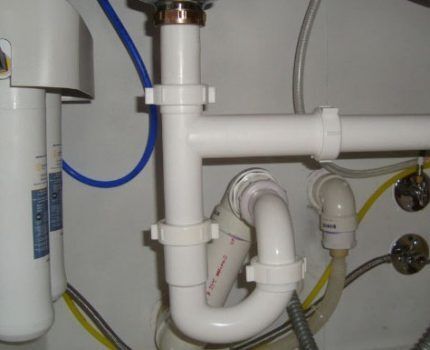
If there is a heavy clog, the water eventually simply stops flowing and sits in the sink or toilet. This can often happen due to irresponsible washing of small household waste, even simple paper. The problem needs to be fixed as quickly as possible before it gets worse.
The water seal is provided by:
- There are siphons on sinks, sinks, bathtubs and shower trays.
- In bathrooms, washrooms, laundry rooms, and garages, drains are installed in the floor.
- Toilets have a built-in elbow.
- In dishwashers and washing machines, the water seal is created by placing a drain hose with a lift, or using a special device.
Among other things, water seals are the most common place for garbage jams to occur.
They are present in any sewerage system, with the exception of very primitive drainage systems, which are found in some dachas. This is also the simplest situation, which most often can be dealt with on your own.
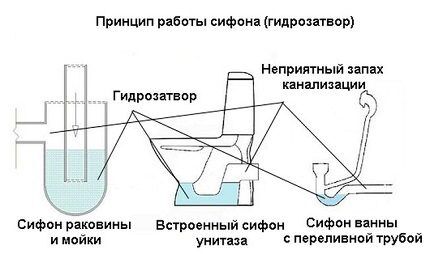
The main culprits of blocked pipes
To ensure that the debris plug is removed in a way that is guaranteed and safe for the pipes themselves, it is important to first determine the cause of its formation. Having found out the reason, it will be possible to say exactly how to clean the sewer pipes in a private house with your own hands.
The culprits for the formation of these very blood clots in the communication system can be various objects and even ordinary soap. Let's take a closer look at the types of blockages.
Type No. 1 - foreign object
A clogged pipe can occur due to some fairly large object getting into it, which, getting stuck inside, becomes a place for other debris to accumulate.
Hair caught in the bathtub or sink can also be a problem. In large numbers, they form such a serious knot that simply hot water cannot be dealt with.
It is possible to get rid of such a plug from the hair if you remove it mechanically or using a cleaning agent.

Plain paper, even simple toilet paper, thrown down the toilet, can become a serious cause of clogged sewer pipes.
Type No. 2 - salt and fat deposits
Narrowing of the pipe walls can occur due to the accumulation of solid deposits on them. They are often formed from various wastes. Waste can be of both organic and inorganic origin.
The formation of a thick fat deposit inside the pipes can be facilitated by the adhesion and settling of numerous fat particles in the sewer system.
Using hard water is one of the common causes of clogs in pipes. Water with high hardness forms salt deposits much faster. Metal pipes are especially vulnerable to hard water.
To prevent this problem from arising, experts recommend installing grease traps to the sewer.They effectively filter used water and do not take up much space.
Type No. 3 - soap stopper
Soap clogs form when you frequently use soapy water in the sink and bathtub. It is difficult to get rid of because soapy water, once in the sewer, usually mixes well with other debris and hardens into a dense plug.
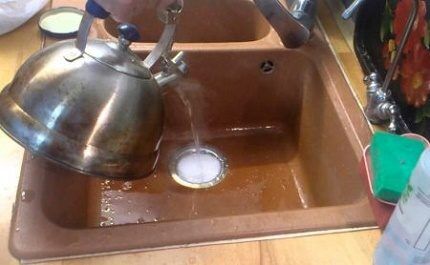
The cause of a clogged sewer can also be errors made during the design and/or installation of communications. They create areas that are problematic for the passage of water, in which there is always a high risk of garbage jams.
In such cases, significant repairs are necessary, unless reinstallation the entire system again, of course, if you do not want to regularly deal with the consequences of these errors.
Effective ways to remove clogs
If preventive measures fail to prevent the traffic jam from occurring, you will have to move on to eliminating it.
The methods of dealing with sewer blockages themselves can be divided into several types:
- thermal;
- chemical;
- mechanical;
- hydrodynamic.
They all have their own nuances, features and approaches to eliminating not only the cause of the blockage, but also the blockage itself. You can also combine some of them when cleaning sewers in a country house or in a private house, especially in case of serious problems.
Method No. 1 - hot water
In bathrooms, soap deposits can accumulate on pipes; these can be dealt with very effectively by rinsing with hot water, preferably with the addition of soda, for greater efficiency.
In this case, the blockage most likely will not cause much trouble. You just need to take into account that to rinse with hot water you will need quite a lot - several buckets. In a similar way, it is quite possible to deal with fatty deposits on kitchen plumbing.
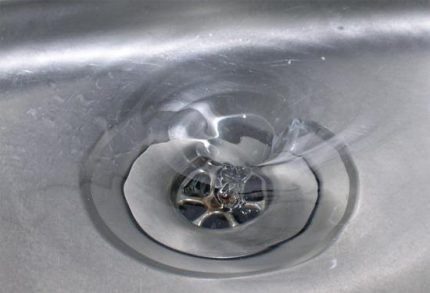
If there is no possibility or desire to disassemble the pipes in order to get closer to the problem area, you can use a hose to run hot water deep into the pipe.
Method No. 2 - mechanical removal
If it was not possible to rinse with boiling water, then you will have to use a plunger, but you must first make sure that any other holes in the sewer are tightly closed.
When this procedure does not bring the desired result, you will have to resort to using a plumbing cable.
Not everyone can handle the cable alone, so you may have to call a specialist or at least call a partner for help. Of the sewer cleaning methods that you can do yourself, this is the most complex and will require a broader description.
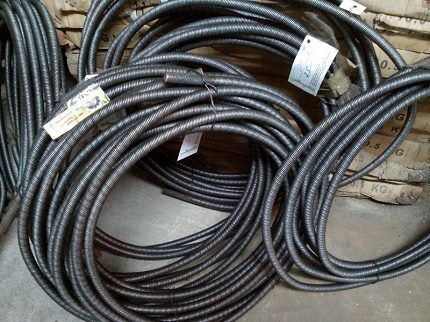
The cables are different. They may differ in various parameters:
- by size - length, diameter;
- in appearance - made like a cable or like a twisted spring;
- additional devices - with tips in the form of a ball, in the form of a spiral, or without one at all.
Spiral cables They screw well into the blockage and often allow you to simply pull it out of the pipe. Cable with ball basically they try to push the blockage further, breaking it into pieces.
Specialists also have an attachment for cables in the form of a frieze or crown, which allow you to cut through the blockage.
You must be very careful when performing rotational movements, especially if you have plastic sewer pipes. It should be taken into account that the cable does not pass through 90-degree turns, as well as siphons.
Therefore, it is introduced through the place where the plumbing is connected to the sewer or through special revisions (a tee with a screw plug) installed on the sewer pipes.
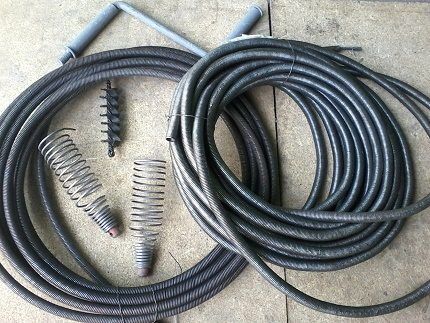
If the cable is of small diameter compared to the pipe, then it can pass through 90-degree turns in the pipeline, but it will feel like the cable has rested against something solid, and after passing the turn, it will move freely again.
You need to act in stages:
- Unwind the cable and insert it into a suitable hole in the sewer pipe.
- You need to push it through with a slight twist until it reaches the blockage. It is important here not to confuse the problem area with the pipe connection.
- To understand that you have reached the goal and did not hit a pipe joint or a 90-degree turn, you should perform a back-and-forth motion with the cable while twisting.If it was a joint or a turn of the pipe, then soon the cable will move quite gently further along the pipe. If this is a clogged area, the cable will begin to resist rotational movements.
- If you are using a tool with a ball or without a tip, try to push the cork further, breaking it up. You can check that the blockage is broken only by carefully filling the pipe with water.
- If you are using a cable with a spiral end, try to hook the clog with it and pull it out of the pipe.
- When the problem has been overcome, the cable is carefully removed, and the pipe is treated with boiling water and/or a chemical to completely eliminate traces of contamination.
When using a device made in the form of a spring, you must not allow it to twist, as this will try to break down or arranged in a spiral inside the pipe, which will not help in cleaning it, but will only cause additional problems.
We also recommend reading the article where we described in detail the types of cables for cleaning sewer pipes and provided instructions for their use. More details - go to link.

Method No. 3 - chemicals
The chemical cleaning method is more likely to be preventive or final after cleaning by another method to consolidate the result.
However, for health safety and to prevent any damage, a number of rules and precautions must be observed:
- Due to the specific composition, different products can harm the communications themselves. This must be taken into account when choosing a product for a specific type of pipe.
- Be sure to follow the necessary precautions when working, usually they are written directly on the packaging of chemicals, because many of them may have toxic fumes.
- Clear blockages in a well-ventilated area.
When you buy plumbing chemicals in a store, be sure to carefully read the instructions: the prescribed dosage volume of the product is poured into the drain.
Then, after the time specified in the instructions, the drain is washed with a strong stream of water. It can be either cold or warm, depending on the manufacturer’s recommendations.
Under no circumstances should different chemicals, since the consequences of this can be completely unpredictable.
In addition, expensive and advertised remedies are not always effective.
Method No. 4 - hydrodynamic cleaning
If you cannot cope with the blockage of a sewer pipe using any method, you can only resort to the last, more radical method - hydrodynamic. It involves removing the blockage with a jet of water under high pressure.
Of course, there are homemade ways to do this yourself at home (with unpredictable consequences), but it is advisable to do this with equipment that is available to specialists in this field.
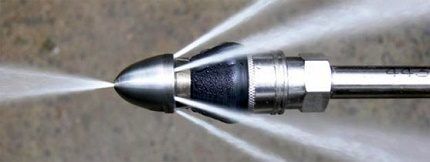
Prevention and prevention of blockages
Currently, there are many different methods to effectively combat garbage jams.But it’s more important not to let the situation get worse and not let the sewer system become clogged.
Any technical equipment and any communications need care and timely prevention, sewer pipes are no exception.
It is enough to follow the usual and accessible, but effective rules:
- Do not dispose of substances that do not dissolve easily down the drain. They belong in the trash can, not in the pipes.
- When installing sewer pipes, it is necessary to install them under a small slope, and large corners should also be avoided, as blockages can collect in them.
- At least once a week, and preferably more often, you need to rinse your sewer drains with boiling water for several minutes.
- Special grates must be installed in the drains to prevent debris from entering the pipeline and clogging it. It is easier to clean the grate itself than to remove waste from the pipe.
- Never leave small objects, bags or rags in the immediate vicinity of the drain - they can easily end up in the pipe and cause serious problems for you.
When carrying out renovation or construction work in your home, pay double attention to drainage issues.

Conclusions and useful video on the topic
You can learn how to properly use a plumbing cable from the following video:
Following simple rules and precautions will minimize the risk of blockages in your sewer system, wear and tear, damage from chemicals, and generally extend its service life.
By preventing blockages and avoiding labor-intensive operations to remove them, you can save not only a lot of time, but also money.
And what sewer cleaning method do you use? Please tell us about it in the comments section. There you also have the opportunity to ask questions about the topic of the article, and we will try to answer them promptly.




According to experience, the most effective and efficient way is mechanical action on the blockage using a plumbing cable. In this way it is possible to break through 95% of blockages; it will not cope only with the toughest ones. Rinsing with hot water has never helped me, but household chemicals have worked well. I use the old and budget Mole. You fill it overnight and by morning the blockage will dissolve. However, we must remember that it is not suitable for plastic pipes, because it will dissolve them along with the blockage.
I would like to hear advice on how to combat the deliberate blocking of apartment sewer drains by the management company. This action (blocking) in itself is illegal and can lead to flooding of apartments and damage to residents’ property. Therefore, opposition is quite acceptable. Is it possible in principle to unblock a sewer drain yourself?
If you are asking about blocking the sewer drain in a separate apartment of the debtor, then this has been practiced for a long time. For example, using the Chop-2008 device and the like. The legality of this method is controversial, although it does not pose a threat to other neighbors who regularly pay utilities.
In fact, if we approach it from a legal point of view, then such a disconnection must be carried out by a court decision. If there was no such solution, then you can unblock the sewer drain of your apartment without any consequences. Here's a video about how to remove the plug and also a life hack on how to prevent its installation in the future.
Essentially, this is a partition made of a long bolt that will prevent the installation of a plug.
Hello. Unfortunately, everything is not always as simple as Nikolai described. Often shutdowns are made using a probe with a plug, which is lowered through a common riser to the pipes of a separate apartment. Attempts to remove it yourself rarely lead to good results - either nothing will work, or the plug mechanism will be broken with consequences under Article 15 of the Civil Code of the Russian Federation. The plug can be removed only after full payment of all debts or during debt restructuring and for the work of unlocking they will require 5 thousand rubles for the complexity and use of expensive equipment.
As for legality, the actions are legal according to PP No. 354, Art. 119, ZhK 153, 155.